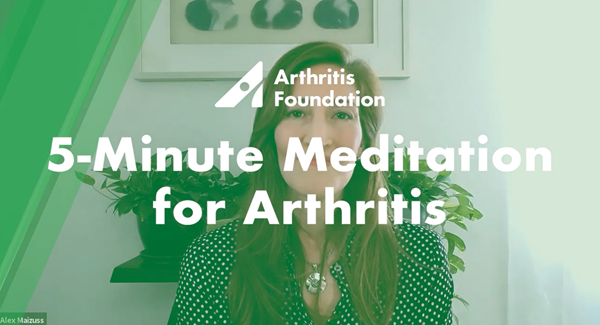Meditation: Benefits for People With Arthritis
Mindfulness and meditation can help you deal with the pain and stress of arthritis.
Could something as simple as taking a few minutes each day to stop, breathe and focus help ease chronic joint pain? Many experts say yes – mind-body practices, especially mindfulness meditation, can help relieve chronic pain and the depression that often comes with it.
What is Meditation?
Meditation is a mind-body practice used to increase relaxation, relieve depression, cope with illness and enhance overall health and well-being.
There are many types of meditation, but most have these four things in common:
It’s done in a quiet place with few distractions.
- You use a comfortable posture (sitting, lying down, walking).
- You focus your attention (on a word or set of words, an object, a body part or your breath).
- You have open attitude (let thoughts come and go without judging them).
One of the most effective forms of meditation for arthritis, mindfulness meditation, is all about focusing solely on the present moment. By doing so, you let go of any attachment or judgement to thoughts, feelings or sensations about pain as they come up.
“Our thoughts can shape our reality,” says Andrea Minick Rudolph, a meditation expert and therapist based in Harrisburg, Pennsylvania. “Mindfulness helps you break the pattern of negative thinking which can make pain worse.”
Does Meditation Work?
Scientific studies back up what millions of people over the centuries have known all along: meditation can help people living with chronic pain.
A 2017 analysis of 38 randomized controlled trials found that mindfulness meditation “improves pain and depression symptoms and quality of life.” However, while the evidence for meditation’s effects on depression were statistically significant, evidence that it helped with pain was modest.
But several 2016 studies found that meditation helps control pain. One, a review published in Military Medicine showed that mindfulness reduces pain intensity, improves function and improves quality of life. Another study, which was presented at the 22nd Annual Meeting of the Organization for Human Brain Mapping in Geneva, Switzerland, found that breath-focused meditation significantly reduced pain-related activity in the brain. Lastly, a study published in JAMA found that mindfulness and another mind-body therapy, cognitive-behavioral therapy (CBT), helped alleviate pain and improve function better than with usual care alone.
Making Meditation Part of Your Treatment Plan
Even while taking powerful medications, some people still struggle with pain and inflammation. For them, learning how to manage their emotions may also help manage their disease, said Alex Zautra, PhD, in an interview before he passed away in 2016.
“Pain is not only a physical experience but an emotional one,” said Zautra who studied the effects of meditation on people with RA and fibromyalgia. “Meditation helps people with arthritis cope more effectively with their symptoms.”
Rudolph agrees. It can’t replace medications, a healthy diet, physical activity or surgery, but it can be a powerful complement to those treatments, she says, noting that the best benefits come from meditating regularly.
“We don’t choose to have arthritis, but we can choose how to respond to and cope with it,” she says. “By not allowing pain to define our lives, we can change how we view and relate to pain. That’s mindfulness –changing our feelings and thoughts around pain."
For more tips on getting started with a meditation practice, visit How to Meditate for Arthritis.

Stay in the Know. Live in the Yes.
Get involved with the arthritis community. Tell us a little about yourself and, based on your interests, you’ll receive emails packed with the latest information and resources to live your best life and connect with others.



